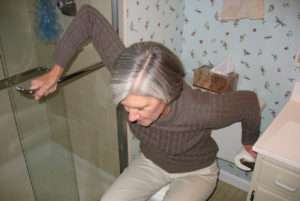Home adaptations are changes you can make to your home. These make it safer and easier to move around and do everyday tasks.
Your local council offers a service that assesses your home and recommends changes to help. Having a home assessment is free.
These changes can be small or big and include:
- fitting a stairlift or a banister on the stairs
- adding a bath lift, walk-in shower or a rail you hold to pull yourself out of the bath (grab rail)
- widening doorways
- lowering kitchen worktops
- putting in an outdoor ramp or step rail
- security, such as outside lights and intercom systems
The assessment might also recommend household equipment and gadgets to make life easier.
How to get a home assessment
If you, or someone you know, needs help to do everyday tasks or you’re worried about falling, ask social services for a home assessment.
You can call your local council or do it online.
What happens during the assessment
An occupational therapist will visit you at your home. They’ll ask you questions and walk around with you to see what you struggle with. You’ll work out what you need together.
Make sure you tell them everything you find difficult, even small things such as opening a cupboard.
Assessments usually take at least an hour.
You might also be referred for a needs assessment to see if you could benefit from extra help at home.
Have someone with you
Ask a friend or relative to be with you. It might help if you’re not confident explaining your situation. They can also take notes for you.
You can use an advocate if you can’t get a friend or relative. These are people who sit with you during an assessment and speak for you. They can also help you fill in forms. They’re often free.
Get help with costs of home adaptions
Small adaptations are often free
Your council should pay for each adaptation that costs less than £1,000. This usually includes things such as:
- grab rails
- a concrete ramp or steps
- lights that come on when someone is at your front door
You might be able to get help with costs
For expensive adaptations, like fitting a wet room or widening doors, you can try to get a grant from:
A Home Improvement Agency (HIA) can help you find schemes to help with the cost of adaptations. Find out if there’s an HIA in your area.
Some local councils might be able to help with the cost of urgent home alterations. Check with your council or HIA.
Further help and advice
- Living Made Easy gives free advice about home adaptation
- Independent Age has advice on home adaptation
- Money Helper has advice about funding to adapt your home for accessibility
How to complain about a home assessment
If you’re not happy about your home assessment, you have a right to complain.
First complain to your local council. It should have a formal complaints procedure on its website.
If you’re not happy with the way the council handles your complaint, contact the local government and social care ombudsman. This is an independent person who looks into complaints about organisations.
In-Home Occupational Performance Evaluation (I-HOPE) Kit
The In-Home Occupational Performance Evaluation (I-HOPE) targets activities performed in the home that are essential for aging in place. The purpose of the I‐HOPE is to measure the effects of an incompatibility between a person’s abilities and the environment or the “person-environment misfit” of older adults and their homes.
The I-HOPE helps therapists measure clients’ in‐home activity performance, and observe changes in person‐environment fit before and after home modification interventions.
The I-HOPE offers a psychometrically sound assessment of daily activities that considers the client’s perspective and satisfaction while recognizing the role of the environment on performance.
The researchers of the Participation, Environment and Performance Lab developed the I-HOPE in response to the lack of performance‐based assessments that evaluate function in relation to the environment.
Jump to ordering information »
How it works
The I-HOPE is a multistep assessment that is conducted in the home of an individual by a trained rater. The I-HOPE takes approximately 60 minutes to conduct and requires no specialized equipment beyond the materials included in the kit.
Materials include:
- Manual
- Assessment forms
- Barrier list
- Activity cards
- Response cards
- Summary score sheets
Three easy steps

Step 1:
An assessment of current in-home activities is conducted using a set of 44 cards of images depicting older adults participating in daily activities. An overall score for activity performance is then calculated.

Step 2:
Priority activities are identified for intervention and given a subjective performance and satisfaction score.

Step 3:
Performance-based rating of barriers’ influence on performance
Understanding the results
The I-HOPE yields four sub-scores that can be used individually or as a profile of performance.
Sub-ScoresConstructCalculationActivityProportion of problematic activitiesSum of activity difficulty scores / number of activities the person wants to doPerformanceSubjective performance of daily activitiesMean of rating for prioritized problemsSatisfactionSubjective satisfaction with performance of daily activitiesMean of rating for prioritized problemsTotal Barrier SeverityInterviewer rating of person-environment fitSum of each rating
Training
Please see our I-HOPE training page for information on I-HOPE training.
How to order
NOTE: A signed copyright notice is required before we can process your order. Please download, sign and return to [email protected]. Directions for signing documents using Adobe software can be found here.
Appropriate shipping costs must be included with online or paper orders.
To order the I-HOPE online using a credit card, click the button below.
I-HOPE ORDER
To order the I-HOPE using tax-exempt status, by purchase order or by check, please contact us at [email protected].
For additional information on the development of the I-HOPE:
Stark, S. L., Somerville, E. K., & Morris, J. C. (2010). In Home Occupational Performance Evaluation (I-HOPE). The American Journal of Occupational Therapy, 64(4), 580–589.
Use of I-HOPE in practice
AOTA Home safety and accessibility assessments
Example of I-HOPE used by Rebuilding Together
Occupational Therapy Home Assessment | What Does It Entail?
Thursday, August 1, 2019
Occupational therapy uses activities to help improve your physical and mental health after an accident, injury, or illness leaves you with some disabilities.
When you lose your sense of independence, it’s common for people to become frustrated and depressed. With the help of occupational therapy, people are able to regain their confidence and find a new sense of well-being with their disability.
One aspect of occupational therapy is the necessity of home assessments. Here, we’ll talk about what a home assessment entails and all the information you’ll need to know as a current or future client.
What is an Occupational Therapy Home Assessment?
Before you are discharged from hospital, your occupational therapist will briefly visit your home to do an assessment. There, they will be able to identify any potential problems you may have in managing your home with your disability.
By completing a home assessment, your occupational therapist will be able to offer advice on how to adjust in your home or help with equipment that can make your life better, safer and functional .
You, your family, and your carers will have the opportunity to ask questions and let your therapist know what issues you foresee and they can point you in the right direction to avoid any unsafe situations.
Why Are Home Assessments Necessary?
Home assessments are an essential part of the occupational therapy process for a few reasons. At your home assessment, your therapist will:
- See if you’re able to get home safely. Are there stairs involved? Are the doors wide enough?
- Advise about obvious dangers like exposed wires that you may not be aware of.
- See if you’re able to manage household tasks such as getting in and out of bed.
- Suggest equipment that might be helpful such as a raised toilet seat.
- See if you need additional help from a carer.
How Will I Get to My Home Assessment?
Some people who are new to occupational therapy might be worried about getting to their home assessment. Don’t worry because transport from hospital will be arrange for you at no additional cost.
Who Will Be at My Home Assessment?
Of course, an occupational therapist will be present and will be leading the home assessment to make sure everything gets covered. It’s also recommended that you invite a family member or friend to come along as well, especially if that person helps to care for you.
If it’s known that you might have problems with physical movements such as walking upstairs, it’s not uncommon for a physiotherapist will be present too.
Sometimes, a social worker or assessment officer and a district may also be present. They’re there to assist in the process if it becomes obvious that you’ll need some support services equipment upon discharge from hospital.
How Long Will a Home Assessment Take?
Home assessments are rather brief and shouldn’t take longer than an 1-2 hours. Still, you’ll want to set aside enough time so that your occupational therapist can get a clear idea of how you’ll manage in your home from here on out.
An hour is the average time but you’ll be given as much time as you need and to what your occupational therapist is deemed appropriate.
How Should I Prepare for My Home Assessment?
There’s no need to be nervous about your home assessment. Your occupational therapist is there for you and they want you to succeed. Still, there are a few things you can do to prepare.
If it becomes clear that a home assessment will be helpful in your occupational therapy, you’ll be notified at least 24 hours in advance. That’s when you’ll want to notify any family or friends that you hope to be there.
On the day of your home assessment you should have:
- Suitable clothing as well as the everyday clothes you might wear at home.
- Suitable footwear.
- A key to your home or someone already at your home who is able to let everyone inside.
You’ll also want to make sure to let a staff member know of any potential impediments to the home assessment such as if you get travel sickness or you can’t stand for extended periods.
What Happens After the Home Assessment?
Your occupational therapist will collect all the information gathered at your home assessment and complete a totally confidential report. It will highlight the problems associated with your home and your disability as well as offer suggestions for improvement.
Copies of this report will be made for your carers and, of course, you’ll have access to the report if you’d like as well.
If it was decided that you need support equipment or any adjustments made to your home, your occupational therapist will make all the orders and schedule for them to be fitted and installed.
After your home assessment was deemed successful, you’ll be taken back to hospital in order to prepare for discharge or continue to live in your preferred setting.
What Happens If I Can No Longer Manage at Home?
Disabilities, especially those that happen suddenly, are absolutely life-changing. It’s no wonder that you might be emotional at the thought of being unable to manage yourself in your own home, but don’t worry – your occupational therapist is here to help.
In most cases, home assessments that find minor issues are sorted out relatively quickly with simple tools to assist with everyday tasks.
In some other cases, your home may present a lot of problems, and things might take a little longer to get sorted. Your occupational therapist will help you cultivate better coping mechanisms to deal with the prospect that you may need to live somewhere else or receive more help from carers.
Again, the home assessment is not a test, and if you decide not to follow the advice given by your occupational therapist, this won’t prevent you from returning home. It’s simply a safety measure in an attempt to prevent re-admission to the hospital.
Occupational Therapy at Physio Inq
People living with disabilities face daily challenges and most days are truly an uphill battle. Our occupational therapy services across Australia help our clients to regain their independence and live more fulfilled & Independent lives.
How To Make A Booking Or Referral
If you would like to see if we have Occupational Therapy services available in your local area, please find your local Occupational Therapy service HERE.
If you would like to see if we have Occupational Therapy services available in your local area, please find your local Occupational Therapy service
At Physio Inq we are delighted to offer a range of different types of Occupational Therapy services which include;
For our Occupational Therapy services, you can make an appointment OR referral with us online today!
Depending on your needs & clinician availability, you may be able to see a therapist within 48 hours. Call us directly today on 1300 731 733



